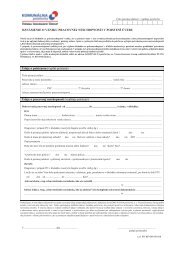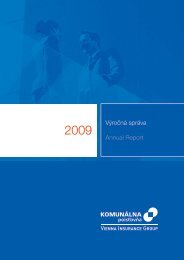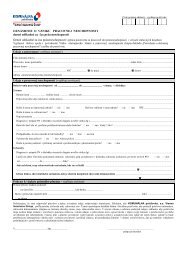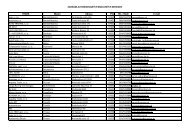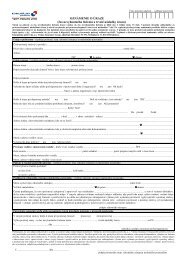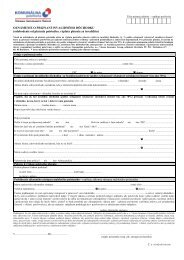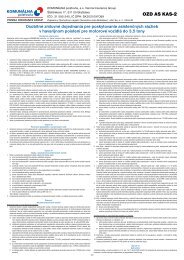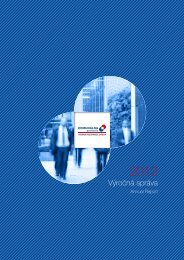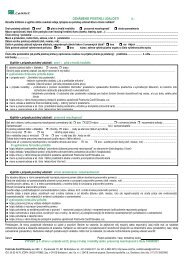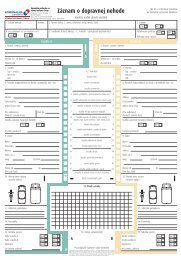kontinuita - Komunálna Poisťovňa
kontinuita - Komunálna Poisťovňa
kontinuita - Komunálna Poisťovňa
You also want an ePaper? Increase the reach of your titles
YUMPU automatically turns print PDFs into web optimized ePapers that Google loves.
NOTES TO<br />
THE FINANCIAL<br />
STATEMENTS<br />
Company establishes a fair value by using valuation<br />
techniques. These include, for example, the use of recent<br />
arm’s length transactions, reference to other financial<br />
instruments that are substantially the same,<br />
discounted cash flow analysis, and option pricing models,<br />
with the maximum use of market inputs and the<br />
minimum inputs that are specific for the Company.<br />
2.6 Impairment of assets<br />
(i) Financial assets carried at amortized cost<br />
At each balance sheet date, the Company assesses<br />
whether there is any objective indication that a financial<br />
asset or a group of financial assets is impaired. A<br />
financial asset or a group of financial assets is impaired<br />
and an impairment loss is recognized only if<br />
there is an objective indication of impairment as a result<br />
of one or more events that have occurred after the<br />
initial recognition of the asset (a ‘loss event’), and that<br />
loss event (or those lost events) has (have) an impact<br />
on the estimated future cash flows of the financial<br />
asset or a group of financial assets that can be reliably<br />
estimated. An objective indication that a financial asset<br />
or a group of financial assets is impaired includes the<br />
following:<br />
• significant financial problems of the debtor or issuer;<br />
a breach of contractual conditions, such as a default in<br />
payments;<br />
• a creditor, due to legal or economic reasons related<br />
to the debtor’s financial problems, gives the debtor a<br />
discount which was originally not meant to be provided;<br />
• it becomes probable that the issuer or debtor will<br />
enter into bankruptcy or other financial reorganization;<br />
• termination of the active market for the given financial<br />
asset due to financial difficulties;<br />
• observable data indicating that there is a measurable<br />
decrease in the estimated future cash flow from a<br />
group of financial assets since the initial recognition of<br />
those assets, although the decrease cannot yet be<br />
matched to individual financial assets in the group, including:<br />
- adverse changes in the solvency of issuers or debtors<br />
in the group; or<br />
- national or local economic conditions that correlate<br />
with defaults on the assets in the group.<br />
The Company first assesses whether objective indications<br />
of impairment exist individually for financial assets<br />
that are significant. If the Company concludes that<br />
no objective indications of impairment exist for an individually<br />
assessed financial asset, whether significant<br />
or not, it includes the asset in a group of financial assets<br />
with similar credit risk characteristics (categorized<br />
by asset type, industrial sector, territory,<br />
maturity, and similar relevant factors) and collectively<br />
assesses them for impairment. Assets that were individually<br />
assessed for impairment and for which an impairment<br />
was identified are not included in a collective<br />
assessment of impairment.<br />
Future cash flows in a group of financial assets that are<br />
collectively assessed for impairment are estimated on<br />
the basis of contractual cash flows from the Company’s<br />
assets and historical loss experience for the Company’s<br />
assets with similar credit risk characteristics.<br />
Historical loss experience is adjusted based on current<br />
observable data to reflect the effects of current conditions<br />
that did not affect the period the historical loss<br />
experience is based on and to remove the effects of<br />
conditions in the historical period that do not exist any<br />
more.<br />
If there is an objective indication that an impairment<br />
loss has been incurred on loans and receivables or investments<br />
held to maturity, the amount of the loss is<br />
measured as the difference between the asset’s carrying<br />
amount and the present value of estimated future<br />
cash flows discounted at the financial asset’s<br />
original effective interest rate. The carrying amount of<br />
the asset is reduced by using a valuation allowance account,<br />
and the loss is recognized in the income statement.<br />
If an investment held to maturity or a receivable<br />
or a loan has a floating interest rate, then the discount<br />
rate for measuring any impairment loss is determined<br />
KONTINUITA ANNUAL REPORT 107



